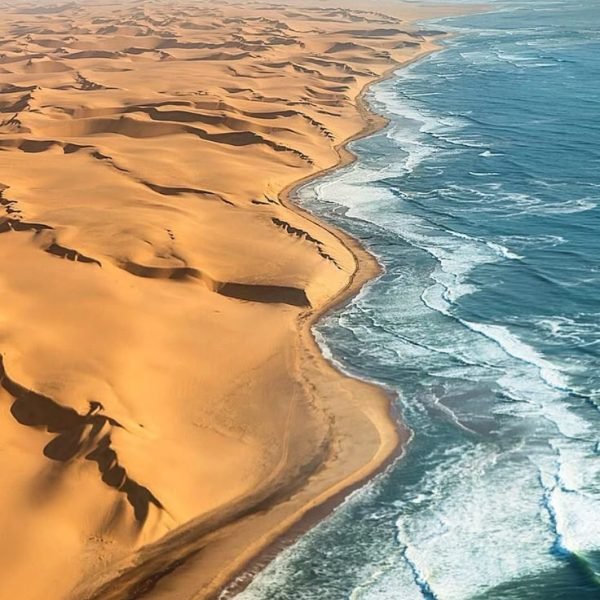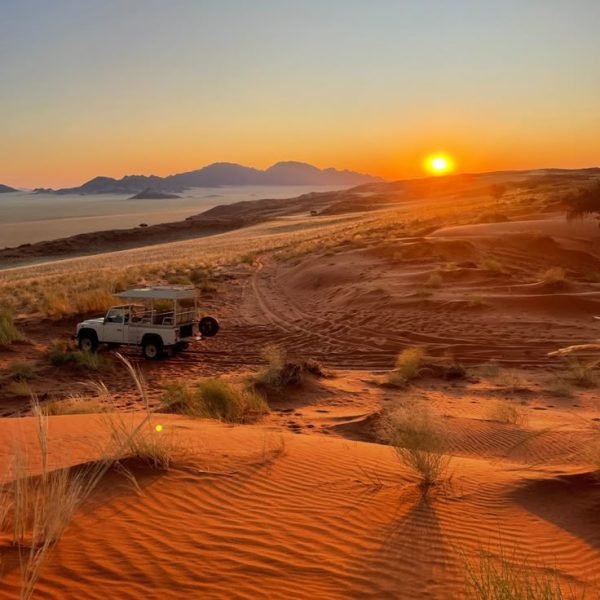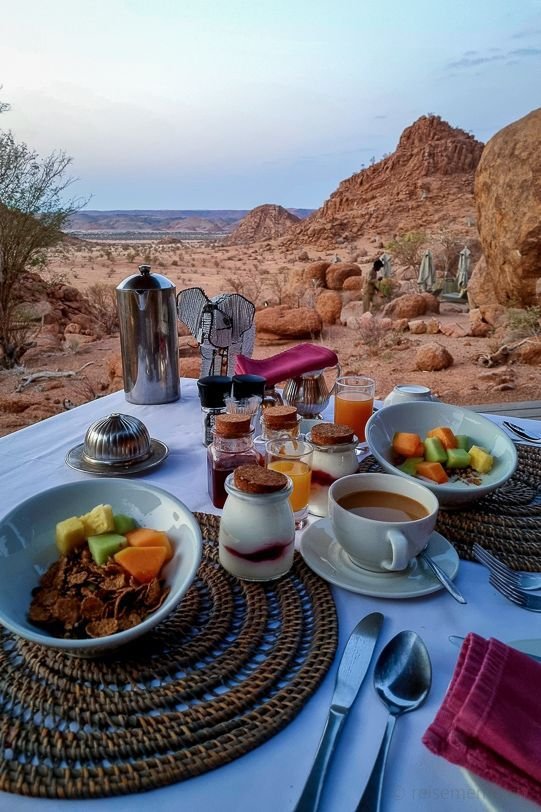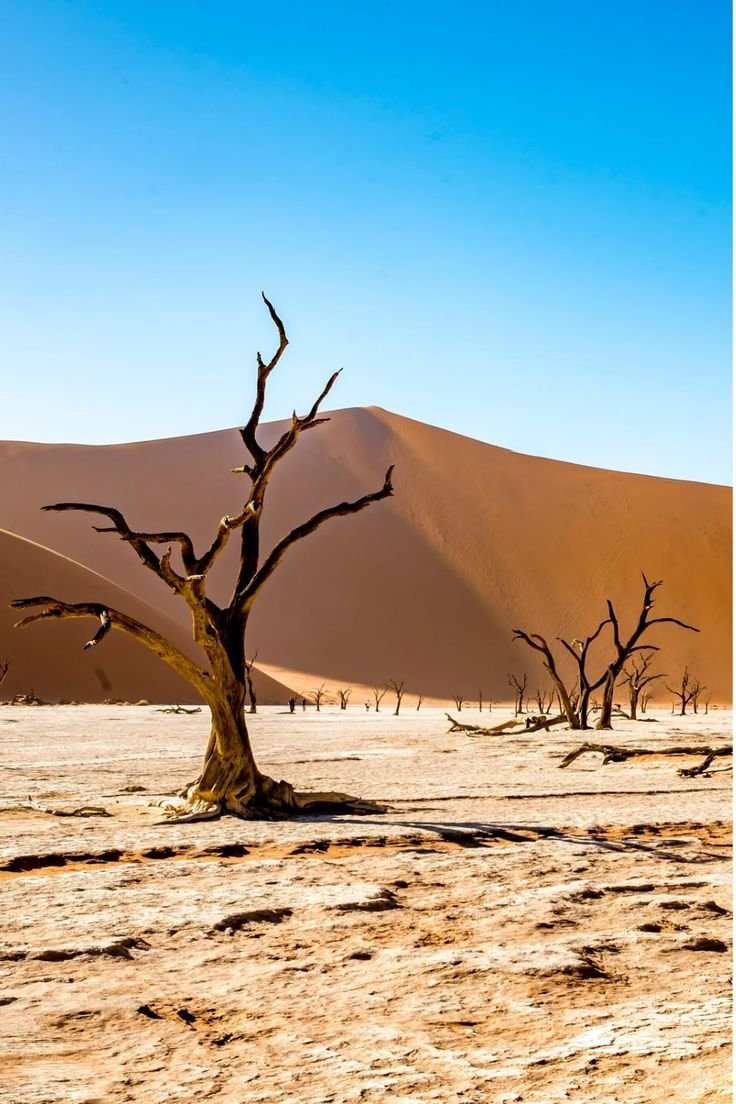Namibia
Welcome to Namibia
Namibia is approximately three times the size of the United Kingdom but has a population of only around 2.5 million people, making it one of the least densely populated countries in the world. This sparse population means much of the country remains untouched, offering pristine landscapes and abundant wildlife. The capital city, Windhoek, meaning "windy corner," serves as a gateway to Namibia’s diverse regions, from the towering dunes of Sossusvlei and the wildlife-rich Etosha National Park to the haunting Skeleton Coast and the cultural heartland of Damaraland. The country is renowned for its wide-open spaces, incredible biodiversity—including desert-adapted elephants and increasing rhino populations—and fascinating cultural groups such as the Himba and San peoples. Namibia’s road network spans nearly 65,000 kilometers, mostly unpaved, making self-drive safaris a popular and rewarding way to explore the country’s rugged beauty.
1.
Unparalleled Natural Beauty: Namibia’s landscapes are like nowhere else on Earth. From the towering, rust-red dunes of the Namib Desert to the eerie shipwrecks along the Skeleton Coast, every vista feels surreal and awe-inspiring. The vastness and silence of the terrain provide a profound sense of peace and connection with nature.

2.
Wildlife and Adventure: Namibia is home to some of Africa’s best wildlife viewing, including big cats, elephants, black rhinos, and plains game in Etosha National Park. It also offers unique experiences such as rhino tracking in Damaraland and bird watching along the perennial rivers in the Caprivi Strip. For adventure seekers, activities like 4×4 driving, hiking, sandboarding, and fishing abound.

Planning Your Trip
Visa Information
Most visitors to Namibia require a visa, which can often be obtained on arrival or in advance depending on your nationality. Citizens from many countries, including the United States, European Union, and Commonwealth nations, enjoy visa-free entry for stays up to 90 days. It is advisable to check the latest visa requirements from Namibian embassies or official government sources before travel.
Best Time to Visit
The optimal time to visit Namibia is during the dry season, from May to October. This period coincides with winter in the Southern Hemisphere and offers the best conditions for wildlife viewing, as animals congregate around waterholes. The weather is generally sunny and mild, with cooler temperatures in the desert at night. The dry season also means less dust and clearer skies, perfect for photography and outdoor activities.
Visiting during the shoulder months of April and November can also be rewarding, with fewer tourists and the chance to see newborn animals. The wet season (December to March) brings lush landscapes but can make some roads difficult to navigate.
Getting To and Around
Getting to Namibia
Namibia’s main international gateway is Hosea Kutako International Airport, located about 45 kilometers east of Windhoek. The airport is serviced by several international airlines with connections from major hubs in Africa and Europe. From Windhoek, travelers can rent vehicles or join guided tours to explore the country.
Getting Around
Namibia is best explored by car, with self-drive safaris being a popular choice due to the country’s excellent road infrastructure and safety. Although only about 5,000 kilometers of roads are paved, the gravel roads are generally in good condition, and 4×4 vehicles are recommended for remote areas.
For those less inclined to drive, guided tours and safaris are widely available, ranging from luxury lodges to camping adventures. Domestic flights also connect key destinations like Windhoek, Walvis Bay, and Ondangwa, providing quicker access to distant regions.

Accommodation
Namibia offers a broad spectrum of accommodation options that cater to all types of travelers, from budget backpackers to luxury seekers. The country’s vastness and diverse landscapes mean that where you stay can greatly enhance your experience, whether it’s waking up to desert dunes, wildlife at a waterhole, or the Atlantic Ocean breeze.
Accommodation Options
Budget and Mid-Range Options
For travelers on a budget or those who prefer a more independent style of travel, Namibia has numerous community campsites, budget lodges, and self-catering chalets. These are often located near national parks like Etosha or in towns such as Swakopmund and Windhoek. Budget lodges typically offer basic amenities such as shared bathrooms, secure parking, and communal fire pits, with prices ranging from about $20 to $40 per night. These spots provide a great way to meet fellow travelers and enjoy Namibia’s natural beauty without breaking the bank.
Self-catering chalets and rest camps are a popular mid-range choice, especially for families or groups who want a bit more privacy and flexibility. These accommodations usually feature en suite bathrooms, kitchenettes or braai (barbecue) areas, and are priced between $40 and $100 per night. Many are situated within or near wildlife reserves, allowing easy access to game drives and nature walks. Guesthouses in towns offer comfortable rooms with reliable hot water and often include breakfast, making them a convenient base for exploring urban and nearby attractions.
Luxury Lodges and Exclusive Stays
For those seeking indulgence, Namibia’s luxury lodges provide an unforgettable experience that goes beyond just a place to sleep. These lodges are often architecturally stunning, blending seamlessly with the environment—whether perched on a dune overlooking the Namib Desert or nestled beside a waterhole teeming with wildlife. Prices for luxury accommodations start around $200 per night and can exceed $1,000 for ultra-exclusive lodges.
Luxury lodges typically include gourmet meals, guided game drives, sundowners in scenic spots, and personalized service. Some offer private plunge pools, open-air showers, and panoramic views that make each stay a sensory delight. Fly-in lodges in remote regions like Kaokoland or the Skeleton Coast provide a once-in-a-lifetime experience, accessible only by small aircraft and offering unparalleled privacy and wilderness immersion.
Unique Accommodation Experiences
Namibia also offers unique stays such as community-run campsites where you can support local conservation and cultural projects, and eco-lodges that emphasize sustainability. For travelers wanting a blend of comfort and adventure, tented camps in the desert or near wildlife reserves provide a close-to-nature experience with the comforts of a well-appointed lodge.
In cities like Windhoek and Swakopmund, apartment rentals and guesthouses with self-catering facilities are increasingly popular, especially for longer stays or families. These provide the convenience of home-like amenities, including kitchens and Wi-Fi, often at a reasonable price.

Food and Drink
Namibian cuisine is a flavorful reflection of its cultural diversity and natural resources, blending indigenous traditions with influences from German, Afrikaans, and other European settlers. Food in Namibia is hearty, often centered around meat, fresh produce, and locally sourced ingredients, making dining an integral part of the travel experience.
Traditional Namibian Dishes
A must-try is biltong, dried and cured meat similar to jerky but typically more tender and flavorful. It’s a popular snack across the country. Another staple is game meat, including venison, oryx, springbok, and kudu, often grilled or stewed to bring out rich flavors.
Kapana is a beloved street food—grilled beef strips served with spicy chili sauce and fresh bread or maize porridge. It’s commonly enjoyed in open-air markets and roadside stalls, offering an authentic taste of local life.
Maize-based dishes like pap (a thick porridge) accompany many meals and are usually served with stews or vegetables. Potjiekos, a slow-cooked stew prepared in a cast-iron pot over coals, is a traditional favorite, often featuring a mix of meat and seasonal vegetables.
Dining Options
In cities and tourist hubs such as Windhoek, Swakopmund, and Walvis Bay, you’ll find a wide range of dining options—from casual cafes and street vendors to upscale restaurants. German influence is strong here, so expect to find excellent bakeries, sausages, and hearty breads alongside local fare.
Many lodges and safari camps offer full-board packages with meals that highlight fresh, local ingredients. Breakfasts often include fresh fruit, eggs, and homemade breads, while dinners might feature grilled meats, fresh fish, and seasonal vegetables. Some lodges also cater to dietary preferences, including vegetarian and gluten-free options.
Drinks and Local Beverages
Namibia has a growing reputation for its beer, with several local breweries producing popular lagers and craft beers. The country’s clear waters and quality barley make for refreshing brews that pair well with grilled meats.
Traditional beverages include mahango beer, made from fermented millet, which is enjoyed in rural areas. Rooibos tea, native to southern Africa, is widely consumed and appreciated for its health benefits.
Wine lovers will find Namibian wines emerging on the scene, though South African imports remain dominant. Many lodges and restaurants offer well-curated wine lists featuring regional selections.

Must-See Attractions
Namibia is a land of breathtaking contrasts, where vast deserts meet rugged mountains and wildlife roams freely across expansive plains. Its unique natural and cultural landmarks make it a top destination for travelers seeking both adventure and tranquility.
- Sossusvlei and Deadvlei
Sossusvlei is arguably Namibia’s most iconic attraction. Located in the Namib Desert, it features towering red sand dunes that are among the highest in the world, some reaching over 300 meters. The dunes glow spectacularly at sunrise and sunset, creating surreal landscapes perfect for photography and exploration. Nearby is Deadvlei, a white clay pan dotted with ancient, dead camelthorn trees that stand in stark contrast to the vivid dunes and deep blue sky. The otherworldly scenery here is unforgettable and accessible by 4×4 vehicles, with options to hike the dunes for panoramic views.
- Etosha National Park
Etosha National Park is one of Africa’s premier wildlife destinations and a must-visit for any safari enthusiast. The park centers around a massive salt pan so large it can be seen from space. During the dry season, animals such as elephants, lions, black rhinos, giraffes, and zebras gather around waterholes, offering excellent game viewing opportunities. Etosha is unique in that it allows self-drive safaris, giving visitors freedom to explore at their own pace. Bird watchers will also delight in over 340 species, including flamingos and eagles.
- Kolmanskop Ghost Town
This eerie, sand-filled ghost town near Lüderitz offers a glimpse into Namibia’s diamond mining past. Once a bustling settlement, Kolmanskop was abandoned and gradually reclaimed by the desert. Guided tours take you through sand-strewn houses and old mining buildings, creating a hauntingly beautiful photo opportunity. The town also features a quaint café and curio shop, making it a fascinating stop for history buffs and photographers alike.
- Twyfelfontein
Twyfelfontein is a UNESCO World Heritage Site famous for its extensive collection of ancient rock engravings and paintings created by the San people over 6,000 years ago. Located in the arid Damaraland region, it is one of Africa’s largest and most significant rock art sites. Visitors can explore the petroglyphs depicting animals and human figures, and learn about the rich cultural heritage of Namibia’s indigenous peoples.
- Fish River Canyon
The Fish River Canyon is the second largest canyon in the world and a spectacular natural wonder. Located in southern Namibia, it stretches over 160 kilometers long and up to 27 kilometers wide, with dramatic cliffs plunging hundreds of meters into the gorge below. Hiking enthusiasts can tackle the challenging Fish River Canyon hike, a multi-day trek that offers stunning views and encounters with unique desert flora and fauna.
- Skeleton Coast
The Skeleton Coast, named for its treacherous shores and shipwrecks, is a hauntingly beautiful stretch along Namibia’s Atlantic coast. Visitors can explore abandoned whaling stations, seal colonies, and vast sand dunes that meet the ocean. The foggy coastline and rugged terrain create a mysterious atmosphere, perfect for adventurous travelers interested in history and nature.
- Spitzkoppe
Known as the “Matterhorn of Namibia,” Spitzkoppe is a group of dramatic granite peaks rising sharply from the desert floor. These ancient rock formations, some over 700 meters high, are popular with climbers, hikers, and photographers. The area also features prehistoric rock paintings and offers spectacular sunsets that bathe the rocks in warm hues.
- Caprivi Strip
The Caprivi Strip is a lush, riverine region in northeastern Namibia, contrasting sharply with the country’s arid interior. It is home to four major game reserves and abundant wildlife, including large elephant populations. The area’s wetlands and rivers make it a birdwatcher’s paradise. Visitors can enjoy boat cruises, fishing, and cultural tours in this verdant corner of Namibia.

Must-Do Activities
Namibia’s diverse landscapes and wildlife provide a playground for a wide range of activities, from adrenaline-pumping adventures to tranquil nature experiences.
- Safari and Wildlife Viewing
A safari in Namibia is a highlight for many visitors. Etosha National Park offers some of the best game viewing in Africa, especially at waterholes where animals gather during the dry season. Self-drive safaris are popular here, allowing you to explore at your own pace and spot lions, elephants, rhinos, and more. Guided safaris in private reserves offer more exclusive wildlife encounters, including night drives and tracking endangered species like black rhinos.
- Climbing and Hiking
For outdoor enthusiasts, Namibia’s rugged terrain offers fantastic hiking and climbing opportunities. Climb the famous “Big Daddy” dune in Sossusvlei for breathtaking views of the desert. The Fish River Canyon hike is a challenging multi-day trek through spectacular scenery. Hiking trails around Spitzkoppe provide access to rock art sites and stunning granite formations. Guided walks in Damaraland and the Brandberg area offer chances to see desert-adapted wildlife and ancient rock paintings.
- Cultural Tours
Namibia’s rich cultural heritage can be explored through visits to local communities. The Himba people in northern Namibia offer fascinating insights into traditional lifestyles, jewelry, and customs. Cultural tours often include village visits, craft markets, and interactions with indigenous groups like the San bushmen, known for their tracking and hunting skills.
- Scenic Flights and Hot Air Ballooning
To truly appreciate Namibia’s vastness and diverse landscapes, consider a scenic flight or hot air balloon ride. Flights over Sossusvlei reveal the endless dunes and salt pans from above, while ballooning at sunrise offers a magical perspective of the desert and wildlife below. These experiences provide unforgettable photo opportunities and a sense of awe.
- 4×4 Adventures and Desert Exploration
Driving a 4×4 through Namibia’s rugged terrain is an adventure in itself. Popular routes include the Skeleton Coast, Damaraland, and the remote Kaokoland region. Off-road driving lets you explore hidden gems, from ancient petrified forests to remote wildlife areas. Many travelers enjoy camping under the stars in Namibia’s clear desert skies, where the Milky Way is visible in stunning detail.
- Whale Watching and Coastal Activities
The coastal town of Walvis Bay is famous for its rich marine life. Visitors can enjoy boat tours for whale watching, seal colony visits, and kayaking among dolphins and flamingos. The nearby Sandwich Harbour offers a unique landscape where towering dunes meet the Atlantic Ocean, ideal for photography and bird watching.
- Stargazing
Namibia’s low light pollution and clear skies make it one of the best places on Earth for stargazing. Many lodges and campsites offer guided astronomy sessions, where you can marvel at the Milky Way, Southern Cross, and countless constellations. The desert nights provide a peaceful and humbling experience under a canopy of stars.

Travel Tips
Traveling to Namibia offers an extraordinary adventure through some of Africa’s most stunning landscapes and vibrant cultures. To make your trip safe, enjoyable, and culturally respectful, it’s essential to be well-prepared. Here’s a comprehensive guide covering key travel tips, including safety advice, local customs, and basic language essentials to help you navigate Namibia with confidence.
Safety Advice
Namibia is generally considered a safe destination for tourists, but like any travel, it requires vigilance and sensible precautions to avoid common risks.
- Personal Security
- Avoid walking alone after dark, especially in urban areas like Windhoek or Swakopmund. Street lighting can be limited, and isolated areas may pose risks.
- Do not display large amounts of cash, jewelry, or expensive electronics openly. Keep your valuables secure and out of sight.
- When using ATMs, choose machines in well-lit, busy locations, preferably inside banks or shopping centers. Be wary of strangers offering unsolicited help, as ATM scams and theft attempts have been reported.
- Keep your passport, credit cards, and money separate; avoid carrying all important documents together to reduce risk in case of loss or theft.
- Road Safety
- Namibia’s roads are often gravel or sand, with only a small percentage paved. This requires careful driving:
- Drive cautiously and avoid speeding, especially on gravel roads where traction is reduced.
- Do not drive at night outside urban centers due to poor visibility, wildlife crossing, and the risk of accidents.
- Always carry sufficient water, fuel, and at least two spare tires if traveling to remote desert areas. It’s advisable to travel in convoy when venturing into isolated regions.
- Be alert for animals on the road, including livestock and wildlife, which can suddenly appear.
- Emergency roadside assistance is limited outside Windhoek, so be self-reliant and prepared for unexpected situations.
- Health and Medical
- Comprehensive travel insurance covering medical evacuation is strongly recommended.
- Namibia’s healthcare facilities are generally good in major towns but limited in rural areas. Carry a basic first aid kit and any personal medications.
- Malaria risk exists mainly in the northern regions (Caprivi Strip and Kavango) during the rainy season (November to April). Take appropriate anti-malarial precautions if visiting these areas.
- Drink bottled or purified water to avoid stomach issues.
- Emergency Contacts
- For emergencies, dial 112 from a mobile phone or 61 211 111 from a landline to reach police, fire, or medical services.
- Tourist Protection Units are available in major towns like Windhoek and Swakopmund.
- Keep contact details of your country’s embassy or consulate handy, though note that some countries may not have a diplomatic presence in Namibia.
Local Customs
Understanding and respecting Namibian customs enriches your travel experience and fosters positive interactions with locals.
- Greetings and Social Etiquette
- Namibians are generally warm and polite. A simple “Hallo” (Hello) or “Guten Tag” (Good day) in German, or “Mhoroi” in local languages, is appreciated.
- When meeting someone, a firm handshake with eye contact is common.
- It’s respectful to address elders and community leaders with courtesy titles.
- Namibians value privacy and modesty; avoid intrusive questions about personal matters unless invited.
- Dress Code
- Dress modestly, especially in rural areas and when visiting traditional communities.
- Lightweight, breathable clothing is ideal for the hot climate, but bring layers for cooler desert nights.
- Swimwear is appropriate at beaches and pools but should not be worn in towns or villages.
- Photography
- Always ask permission before photographing people, particularly in rural or indigenous communities.
- Avoid taking pictures of government buildings, military installations, or police personnel.
- Tipping
- Tipping is customary but not obligatory. In restaurants, a 10-15% tip is appreciated.
- Safari guides, drivers, and lodge staff often rely on tips as part of their income.
- When tipping, hand the money directly to the person with a smile and a thank you.
- Environmental Respect
- Namibia’s natural environment is fragile. Always follow park rules, stay on designated paths, and do not disturb wildlife.
- Avoid littering; carry out all trash.
- Water is scarce in many parts of Namibia, so conserve it whenever possible.
Language Basics
Namibia is a multilingual country with over 30 languages spoken, but the official language and lingua franca is English. Here are some useful language tips to help you communicate:
- Official Language
- English is used in government, business, and education. Most people in urban areas and tourist sectors speak English well.
- Common Local Languages
- Oshiwambo: The most widely spoken indigenous language, especially in northern Namibia.
- Afrikaans: Widely spoken, especially in the south and among older generations. It’s a legacy of South African influence.
- German: Spoken by a minority, especially in towns like Swakopmund and Lüderitz, reflecting Namibia’s colonial history.
- Other languages include Herero, Damara, Kavango, and San languages.
- Useful Phrases
- Hallo – Hello
- Guten Tag – Good day (German)
- Mhoroi – Hello (Oshiwambo)
- Dankie – Thank you (Afrikaans)
- Tate – Father / Sir (respectful address)
- Mama – Mother / Madam (respectful address)
- Baie dankie – Thank you very much (Afrikaans)
- Ja – Yes
- Nee – No
Using a few local greetings or polite phrases can go a long way in showing respect and building rapport with locals.
Final Tips for a Smooth Journey
Additional Practical Tips
- Currency: The Namibian Dollar (NAD) is pegged to the South African Rand (ZAR), which is also widely accepted. Credit cards are accepted in major towns, but carry cash for remote areas.
- Electricity: Namibia uses type D and M plugs, with a standard voltage of 220-240V. Bring adapters if needed.
- Mobile and Internet: SIM cards are affordable and widely available. Coverage is good in towns but patchy in remote areas.
- Respect Wildlife: Never feed or approach wild animals. Keep a safe distance and follow your guide’s instructions.
- Cultural Sensitivity: Namibia’s communities have diverse traditions and beliefs. Approach cultural sites and interactions with openness and respect.
Namibia offers a spectacular travel experience framed by its stunning landscapes and rich cultural tapestry. To enjoy your visit safely and respectfully:
- Stay vigilant about personal security, especially when handling money or traveling at night.
- Drive carefully on gravel and desert roads, and prepare for remote travel conditions.
- Respect local customs by greeting politely, dressing modestly, and asking permission before photographing people.
- Use English as your primary communication tool, but learning a few local phrases enhances your connection with Namibians.
- Carry travel insurance, stay hydrated, and be mindful of Namibia’s environmental sensitivities.
By following these travel tips, you’ll not only protect yourself but also deepen your appreciation for Namibia’s unique spirit and hospitality. Prepare well, stay curious, and let Namibia’s wild beauty and warm people make your 2025 journey truly unforgettable.

